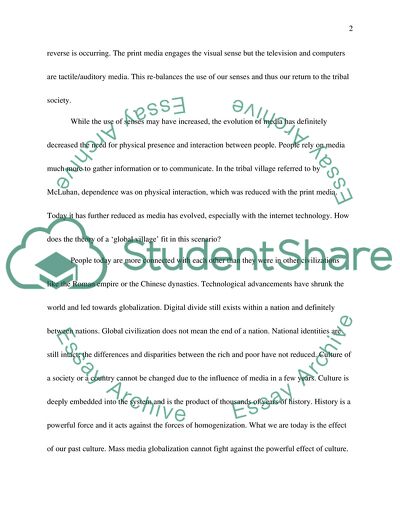
- Home
- Free Samples
- Premium Essays
- Editing Services
- Extra Tools
- Essay Writing Help
- About Us
- Studentshare
- Subjects
- Miscellaneous
- The Search for Meaning in a Global Civilization
The Search for Meaning in a Global Civilization - Essay Example

- Subject: Miscellaneous
- Type: Essay
- Level: Undergraduate
- Pages: 4 (1000 words)
- Downloads: 0
- Author: judd28
Extract of sample "The Search for Meaning in a Global Civilization"
Havel, in the essay, “The Search for Meaning in a Global Civilization” contends that the birth of modern technological civilization, the first civilization in the history of human race, spans the entire globe, and firmly binds together all human societies, submitting them to a common global destiny. The question lingers – are we living in a global village or we a part of the global civilization and what is the common global destiny? Face-to-face communication was the only means of communication before mass communication was possible.
This required the use of all the senses. With the evolvement of the print media, eyesight became the primary sense, as other senses were not involved. Independence increased, as people were no more dependent on others to receive local news. McLuhan’s concept of ‘global village’ is based on the concept that with the advanced media and ICT, the reverse is occurring. The print media engages the visual sense but the television and computers are tactile/auditory media. This re-balances the use of our senses and thus our return to the tribal society.
While the use of senses may have increased, the evolution of media has definitely decreased the need for physical presence and interaction between people. People rely on media much more to gather information or to communicate. In the tribal village referred to by McLuhan, dependence was on physical interaction, which was reduced with the print media. Today it has further reduced as media has evolved, especially with the internet technology. How does the theory of a ‘global village’ fit in this scenario?
People today are more connected with each other than they were in other civilizations like the Roman empire or the Chinese dynasties. Technological advancements have shrunk the world and led towards globalization. Digital divide still exists within a nation and definitely between nations.
...Download file to see next pages Read More
- TERMS & CONDITIONS
- PRIVACY POLICY
- COOKIES POLICY